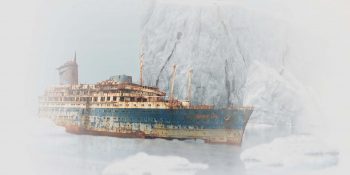By Anne Manning
In a few days, a research vessel called the RV Polarstern will depart Norway and spend a year drifting through the Arctic Ocean, trapped in the ice. More than 600 researchers from 19 countries will board the ship in various stages, participating in the world’s most ambitious Arctic science expedition to date.
Jessie Creamean, a research scientist in the Department of Atmospheric Science at Colorado State University, will be one of them. Starting Sept. 12, Creamean will spend about four months on board the ship, floating toward the North Pole and collecting thousands of ice, snow, seawater, and air samples along the way. Her goal is to determine how biological processes from microbes – like algae and bacteria – in the water, ice, and snow are affecting atmospheric conditions that form clouds.
“Especially up in the Arctic, clouds are like thermostats – they can reflect radiation from the sun or trap heat from the Earth’s surface,” said Creamean, whose colleagues on the project include senior research scientist Paul DeMott and University Distinguished Professor Sonia Kreidenweis. For example, if clouds cause sea ice to melt faster, this could lead to more sunlight exposure in the ocean, and more production of algae that can affect local ecology.
According to research Creamean and DeMott recently co-authored in Geophysical Research Letters, marine bacteria seed clouds in the Arctic, feeding off vast algae blooms and carried by sea spray above the ocean’s surface.
“We don’t have a good grasp, especially in models, of how many of these particles become airborne because we have such limited observations,” Creamean said. “They might have even larger impacts we don’t know about.”
International effort
The MOSAiC expedition (Multidisciplinary drifting Observatory for the Study of Arctic Climate) is a $134 million international effort that will include research aircraft and other “icebreaker” ships, as they are called. The overall mission is to develop a better understanding of declines in Arctic sea ice, and how those declines are linked to climate change. Improved data can then increase the accuracy of regional and global climate models.
Creamean is no stranger to the harsh conditions of Arctic science; this will be her fifth such research journey, although there will be many unique aspects to this endeavor.
“I’ve never been that far north, and I’ve never experienced polar night, when it’s dark all day long,” Creamean said. “I’ve been up to the marginal ice zone, where the ice and seawater form ice floes, but I’ve not been completely frozen in ice.”
Models predict that the ship will float close to the North Pole. By spring, the researchers should be headed for the Fram Strait. When Creamean returns, she and the CSU team led by Kreidenweis will spend several months analyzing data and answering key questions about the behavior of airborne microbes in the Arctic.
Previous experiments
Another researcher in Kreidenweis’ group, Jun Uetake, recently returned from a shipborne research expedition in the Bering and Chukchi Seas, collecting samples for a multi-year partner study documenting changes in the Pacific-Arctic ecosystem. The CSU portion of that study, which Creamean also leads, is called INARCO III (Ice Nucleation over the Arctic Ocean). The researchers also collected data from two previous INARCO studies in 2017 and 2018, which led to their Geophysical Research Letters paper about cloud-seeding marine bacteria.
SPREAD THE NEWS
COMMENT, Like, Follow & SHARE @I70Scout
CURRENT EDITION
WEATHER & TRAFFIC PUZZLES RECENT NEWS ADVERTISE WITH US

Leave a Reply